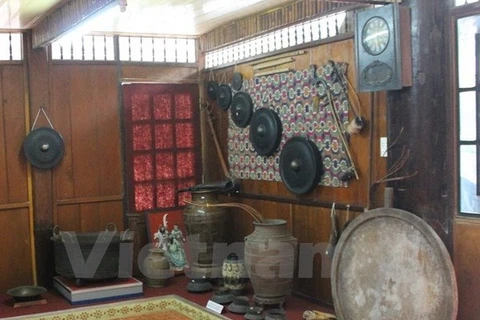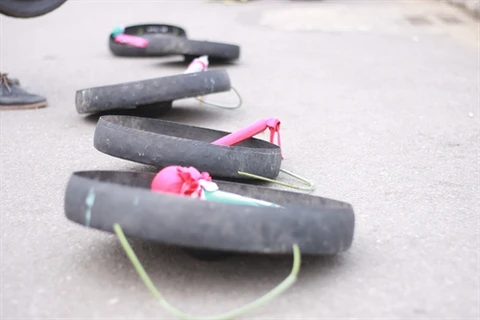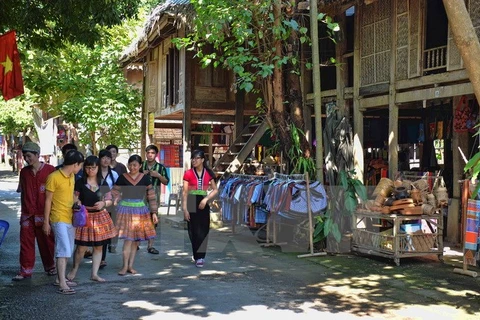Hanoi (VNA) - Mo Muong is a unique cultural heritage of the Muong ethnic group in the northwestern province of Hoa Binh.
It is a job and also a performance practiced at funerals, religious festivals, and life cycle rituals by the Muong ethnic group. The art consists of Mo prayers and performances, by Mo practitioners, or Mo artisans.
Through generations, Mo prayers have been passed down verbally in the community. When they’re collected, translated, and published in books, however, they begin to exist separately from people.
These days, most Mo prayers are called Mo Muong. They are a collection of verses recited at traditional Muong funerals. They are divided into "cat Mo” and "roong Mo”, similar to chapters in literature. Each Mo chapter has its own theme and purposes for each item in a funeral ritual. The chapters may tell folk epics, customs or lessons.
Each Muong community has its own version of Mo, but they are all fairly similar. The existence of various versions of Mo has helped expand the heritage and spiritual life of the Muong people.
Mo Muong has a long life, spanning centuries, as it has always helped to nurture the characteristics and the souls of the Muong people.
It is the essence of labour, production, cultural behaviour and the philosophy of the Muong people, reflecting their love of life and home villages.
According to folk cultural specialists, Mo Muong is classified into three categories: Mo Nghi Le (Ceremonial Mo), Mo Ke Chuyen (Story Telling Mo) and Mo Nhom, in which “thay mo” or mo masters play an important role in forming the essence of the unique culture.
Mo Muong bears a set of values expressed in diverse ways, including:
Folk literature: Mo prayers, legends and epics, reflecting the history, lives, customs, beliefs and languages of the Muong people.
The outlook on life: the conceptions on the life of the Muong people, and the geography of where they live.
The worldview: the Muong people’s conception on the universe, which is believed to have three levels and five worlds, as well as the nature of the Muong people.
Folk knowledge: production experience, calendar, classification of plants, experience in dealing with nature.
Space for Mo performance: the traditional funeral of the Muong people and the system of rites, cultural symbol, burial house, and tomb, for the funeral where Mo is performed.
Folk beliefs: the worship of ancestors, the progenitor of Mo, or ritual for living persons, the worship for good luck and peace, worship of plants, sacrifice rites (as seen in Mo buffalo, Mo cow or Mo chicken).
The educational value of Mo Muong remains relevant in life today. It is an oral textbook.
The value of cultural protection: Though Vietnam experienced almost 100 years under the domination of French colonialists, foreign faiths could never penetrate the Muong community. Mo Muong helps the Muong people and their culture defend against foreign culture.
In short, Mo Muong is the Muong folk encyclopedia that has been orally handed down through many generations.
According to a survey by the provincial Department of Culture, Sports and Tourism, a total of 23 rituals are performed with this ceremonial singing. The role of “thay mo” is associated with the human life cycle: birth, old age, sickness and death. Prayers are for people’s health, good luck, peace, happiness, and prosperity.
Besides reflecting the unique culture of the Muong people, Mo Muong contains educational values for the community. However, this intangible cultural heritage is in danger of going extinct due to the impact of industrialisation and globalisation.
In Hoa Binh, the number of “thay mo” in villages has decreased. Statistics of the provincial Department of Culture, Sports and Tourism showed that the province has 190 artisans, many of them very old.
Since 2010, Hoa Binh has put forth specific solutions to preserve the culture such as supporting the publication of a three-volume book featuring 22,000 lines of Mo verses collected and edited by folk cultural researcher Bui Van Noi.
In 2016, the Ministry of Culture, Sports and Tourism issued a decision bringing Mo Muong into the list of national cultural heritage.
Most recently, Deputy Prime Minister Vu Duc Dam assigned the ministry to work with relevant ministries and localities to compile a dossier to submit to the Prime Minister to seek the UNESCO recognition of Mo Muong as a world cultural heritage item./.
























